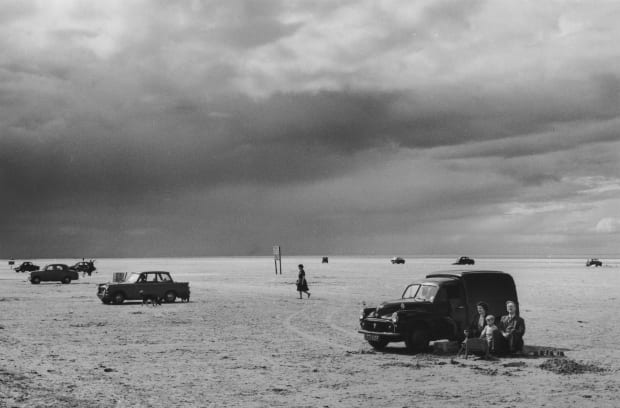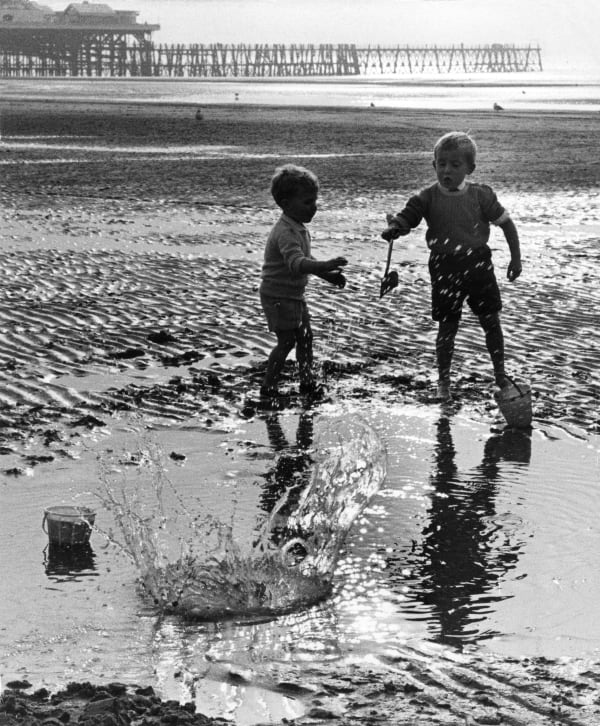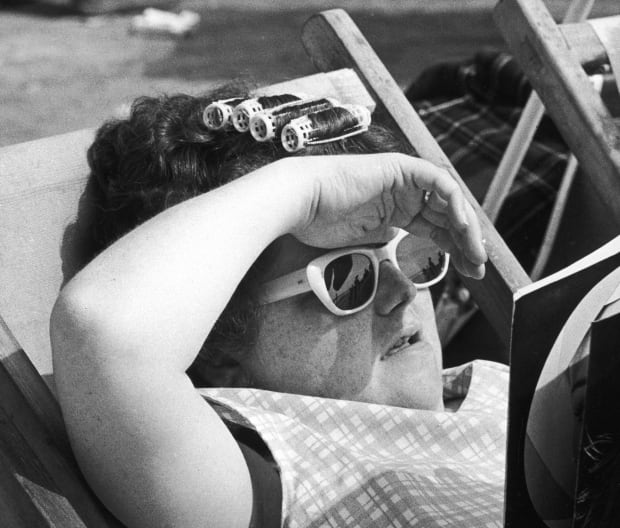-
 Southport, Merseyside, 1961
Southport, Merseyside, 1961 -
Perhaps the most comprehensive and renowned is of these projects is her documentation of post-war slum clearing programmes in Manchester and Salford in the 1960s and 70s, and the affect on the lives of the districts’ inhabitants. This formative body of work was celebrated in the major touring solo exhibition Shirley Baker: Women and Children; and Loitering Men, which opened shortly after her passing in 2014.
-
-
On the nearby beaches of Southport, Blackpool and North Wales, however, she shot more covertly. Baker’s photographs from the late 1960s and early 1970s capture the rituals of sand and sun-seekers, whether splashing in the shallows with a bucket and spade, riding a donkey, or catching 40 winks on a deck chair after lunch. Though her subjects are still very much the people that flock to these beaches, Baker's focus on light and composition within these frames reflects her desire to exercise her artistic eye within her photographic practice, in addition to her important documentary work.
“Baker’s gaze alights kindly on her subjects, never sending them up for a cheap laugh. Her photographs of fathers playing with the children in sand and sea are singularly touching…” – Anna Douglas
To celebrate the start of the summer and Britons' triumphant - yet cautious - return to local beaches post-lockdown, transcribed below from an essay written at the time are Shirley Baker's top tips for photographers shooting on the beach:
1) Do avoid fussy, distracting backgrounds. A small lens aperture is needed on the beach and in bright sunshine and as this extends the range of sharpness, the background can sometimes be almost as sharply in focus as the subject of the picture. A raising or lowering of viewpoint can help to eliminate unwanted detail in the background. On the beach, for examples, the background can be plain sand, from a high viewpoint, or the sky, from a low one.
2) Do get close and fill the frame. Dots on the horizon are of no interest to anyone, whether at Santa Margarita or Southend.
3) Do play it cool. If you see an interesting situation developing, creep up and catch Dad unawares.
4) Don’t be afraid to shoot against the sun. Sometimes the most sparkling pictures result from this kind of lighting.
5) Do remember to increase the exposure by at least a stop, if detail is required in the shadows, when shooting into the light.
6) Finally, don’t forget about the disastrous effects of sand and sea water on photographic equipment. Before picking up the camera, make sure your hands are sand free. Also, use polythene bags for storing the camera and any other bits and pieces of equipment when they are not being used.
-
-
 Shirley Baker, Southport, Merseyside, 1961
Shirley Baker, Southport, Merseyside, 1961 -
 Shirley Baker, Blackpool, Lancashire (girls' donkey ride), 1965
Shirley Baker, Blackpool, Lancashire (girls' donkey ride), 1965 -
 Shirley Baker, Blackpool, Lancashire (boys' donkey ride), 1970
Shirley Baker, Blackpool, Lancashire (boys' donkey ride), 1970 -
 Shirley Baker, Blackpool, Lancashire (bucket and spade), 1965
Shirley Baker, Blackpool, Lancashire (bucket and spade), 1965 -
 Shirley Baker, Blackpool, Lancashire (family), 1970
Shirley Baker, Blackpool, Lancashire (family), 1970 -
 Shirley Baker, Abersoch, North Wales (dangerous), 1967
Shirley Baker, Abersoch, North Wales (dangerous), 1967 -
 Shirley Baker, Abersoch, North Wales (dog), 1968
Shirley Baker, Abersoch, North Wales (dog), 1968 -
 Shirley Baker, Blackpool, Lancashire (sleeping), 1970
Shirley Baker, Blackpool, Lancashire (sleeping), 1970 -
 Shirley Baker, Blackpool, Lancashire (reading), 1970
Shirley Baker, Blackpool, Lancashire (reading), 1970 -
 Shirley Baker, Blackpool, Lancashire (sitting on steps), 1970
Shirley Baker, Blackpool, Lancashire (sitting on steps), 1970 -
 Shirley Baker, Blackpool, Lancashire (crowded beach), 1970
Shirley Baker, Blackpool, Lancashire (crowded beach), 1970
-
-

-

-

-
Signed and annotated vintage or modern prints direct from Shirley Baker’s Estate are available for acquisition from £1,500 + VAT. Enquire directly by clicking on the images above, or email printsales@tpg.org.uk.
See further work by Shirley Baker here.
Discover related books in the Bookshop.
Alexandra Olczak, Print Sales Curator & Sales Advisor
Sources & Further Reading:
[1, 3] Curator Anna Douglas discusses the exhibition Shirley Baker: Women and Children; and Loitering Men (17 Jul-20 Sep 2015), the first London exhibition to present work by the pioneering British photographer: https://vimeo.com/134618902
[2] Essay by Anna Douglas in the exhibition catalogue, Shirley Baker: Women and Children; and Loitering Men (published by The Photographers' Gallery, 2015), p.150-161
https://shirleybakerphotography.com/on-the-beach-blackpool/















